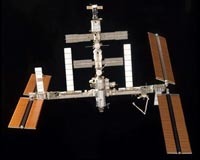
|
| ©NASA - AFP |
The prolongation of the mission means that the Endeavour, launched Wednesday from Cape Canaveral, Florida, will now return to Earth on August 22, a National Aeronautics and Space Administration spokesman said on Sunday.
The extra time will allow a fourth, additional spacewalk to the mission to continue construction work on the International Space Station. On Saturday the ISS was expanded with a new truss segment attached by two astronauts.
Endeavour's tour was initially planned for 11 days, with three space walks. NASA however said from the start said it would extend the mission after testing a new system that transfers electricity from the ISS to the shuttle.
The system, which prolongs the life of the shuttle's batteries and allows it to remain aloft longer, was tested successfully on Sunday.
Meanwhile, NASA engineers at mission control in Houston, Texas, pored over three-dimensional images of a gouge in the shuttle's heat shield. The images were taken Sunday by a camera, and measurements by a laser, both of which trained on the shuttle's underbelly.
The examination took about three hours as the imaging devices atop a 30-meter-long (100 foot) robotic arm coupled with the Orbiter Boom Sensory System (OBSS) scanned five areas on the shuttle underside that may have been damaged during Wednesday's launch from Cape Canaveral, Florida, NASA said.
The gouge, 30.5 x 25.5 millimeters (1.2 x 1.0 inches) -- smaller than initially reported -- and 28.5 millimeters (1.12 inches) deep, was made near a landing gear hatch by a piece of foam, possibly covered with ice, that broke off the shuttle's external fuel tank shortly after blastoff.
Mission Management Team chairman John Shannon said an exact mold of the gash will be reproduced in thermal tiles and tested in a laboratory that simulates the extreme heat and friction the shuttle encounters on reentry to Earth.
NASA engineers will be able to "do a thermo analysis model ... to understand what the actual heating impact of reentry will be for a damage of this type," he told a press conference.
The tests, to be carried out "in the next 24 to 48 hours," should provide engineers enough data to determine whether repairs are needed to the damaged heat shield before the shuttle undocks from the ISS on August 20, he said.
"If it comes back that a repair is desirable to do," he added, "we have three different methods of doing that. I don't have an idea right now whether a repair will be required or which kind of repair" will be used.
The available repair options include heat reflecting paint, a paste to fill in the hole and a metal plate to completely cover the damaged thermal tile.
"We are really prepared for exactly this case since Columbia," Shannon said referring to the February 2003 disaster of the shuttle Columbia that killed seven astronauts.
The foam came off the shuttle's fuel tank, which holds super-cold liquid hydrogen fuel for the takeoff and is jettisoned before orbit is reached. An insulation layer on the tanks is supposed to prevent icing.
NASA keeps a watchful eye on the shuttle's thermal shield since the Columbia disaster.
Columbia's protective heat shield was pierced by a piece of insulating foam that peeled off its external fuel tank during liftoff. The breach resulted in the shuttle disintegrating as it re-entered Earth's atmosphere, killing all seven astronauts on board.
After the examination of the shuttle's underside was completed at 1900 GMT, preparations began for the mission's second spacewalk, due to start at 1531 GMT Monday, during which astronauts Dave Williams and Rick Mastracchio will replace one of the ISS' four control gyroscope.
On Saturday, Mastracchio, of the United States and Canadian Dave Williams spent six hours and 17 minutes installing and activating a new, 1.58-ton segment for the ISS the Endeavour brought up.
Endeavour docked on Friday with the ISS bringing seven astronauts, including 55-year-old Barbara Morgan, the first school teacher in space.



Reader Comments
to our Newsletter